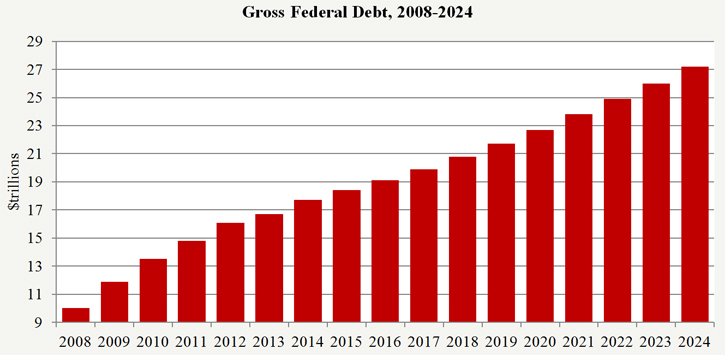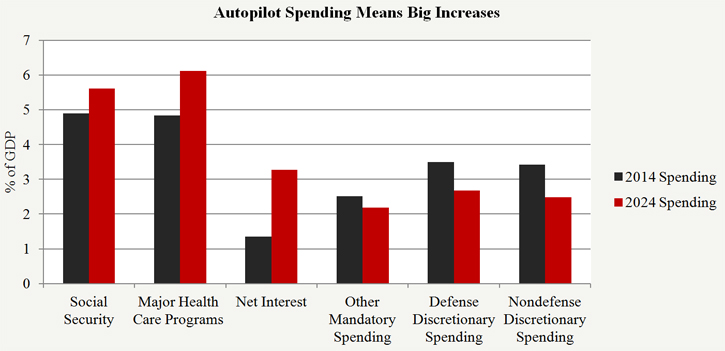A Very Bad CBO Report for Obama’s Policies
Yesterday the nonpartisan Congressional Budget Office released its 2014 Budget and Economic Outlook, which outlines its projections for the next 10 years. The laudable, though limited, restraint in discretionary spending over the past couple of years has led to short-term reductions in the deficit. But mandatory spending reform is still badly needed to prevent fiscal calamity.
Democrats want people to believe that we do not have a fiscal problem anymore. “[O]ur deficits [have been] cut by more than half,” President Obama bragged in his State of the Union address. This CBO report shows that not only do we still have a huge budget problem, but that spending is driving the problem.
Return of Trillion Dollar Deficits
CBO projects that deficits will decrease in 2014 (to $514 billion) and 2015 (to $478 billion) – still larger deficits than any previous Administration – before increasing every single year after 2015. The report estimates that deficits in 2022, 2023, and 2024 will all be greater than $1 trillion. In comparison, last year’s estimate did not expect any deficits over $1 trillion.

By the end of his second term, President Obama will have seen the national debt increase by about $8.5 trillion. It will be nearly $27.2 trillion by 2024. Publicly held debt as a percentage of GDP rises to nearly 80 percent -- double the average of the last 40 years. Democrats will ignore the latter part of the decade and point to declining debt as evidence that their policies are working. But perspective is in order: the last time the U.S. had debt as a percentage of GDP equal to or greater than 72.3 percent (the lowest rate in the CBO projection) was 1950.
CBO warns that an abnormally high debt, like the one it predicts, would do great harm to the economy. Interest costs would skyrocket, which would lead to more debt. National savings would be depressed, providing less domestic capital to invest and create jobs. The federal government’s ability to respond to unexpected emergencies would be curtailed. A fiscal crisis becomes more and more likely the further in debt we get, since we do not know when investors will begin to get nervous about the government’s ability to pay back holders of Treasury bonds.

Mandatory Spending Programs to Run Deficits This Decade
CBO reports that mandatory spending programs will begin to operate in the red. The combined Social Security and Disability Insurance trust funds will begin running annual deficits in 2018. Medicare’s combined operations for Part A and Part B are expected to run deficits sporadically during the next decade, including combined deficits during the last six years (2019-2024).
Total mandatory spending increases by 77 percent over 10 years versus the 2014 estimated level -- including a 78 percent increase in Social Security outlays; an 80 percent increase in Medicare; and a 93 percent increase in Medicaid. For comparison, discretionary spending only increases by 15.8 percent over the 2014 level.
Interest Spending Skyrockets
The biggest increase in spending is net interest – the cost of servicing our debt. CBO assumes that the interest rate on treasuries will rise eventually to near the historical average. Interest spending is estimated to go up by 278 percent over the next decade, from $233 billion in 2014 to $880 billion in 2024. By 2021, interest costs will exceed the entire national defense budget.
CBO highlights the fact that mandatory spending and interest payments are really behind our budget problems when they say all spending other than Social Security, health programs, and interest costs will “drop to its lowest percentage of GDP since 1940.”

Democrats’ Debt Limit Stance – Why So Unserious?
The CBO report continues to show the need to strengthen entitlement programs – to prevent a sea of red ink from overwhelming them. However, the President does not appear to be interested in any long-term, phased-in entitlement reforms unless he also gets immediate tax increases that will harm the economy.
As we approached the past two debt limit deadlines, President Obama said that he would engage in “a vigorous debate” or “a serious argument” once the debt limit had been dealt with. Since that time, Congress has passed two debt limit suspensions that have lasted for well over one full year, but the President still has not come to the negotiating table.
In January 2013 he said that we should “set the debt ceiling aside, we pay our bills, and then we have a vigorous debate about how we’re going to do further deficit reduction in a balanced way.” Congress later passed, and the President signed, a suspension of the debt limit from February 4 through May 18, 2013. The President did not negotiate on deficit reduction once this suspension took place.
In September, 2013, the President repeated, “we can raise the debt ceiling tomorrow just by a simple vote in each chamber, and set that aside, and then we can have a serious argument about the budget.” On October 16, Congress passed a continuing resolution that also suspended the debt limit through February 7, 2014. The President signed this bill on October 17, yet he did not begin negotiations on deficit reduction after this second suspension either.
Mr. President, Americans are still waiting for a “vigorous debate” and “serious argument.”
Next Article Previous Article
